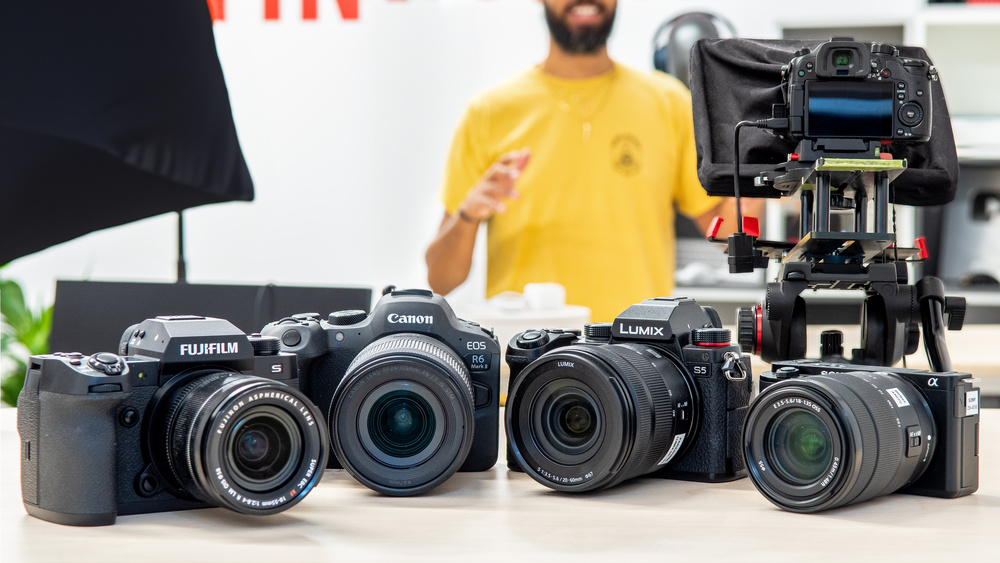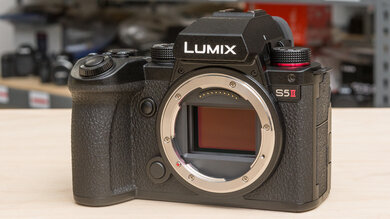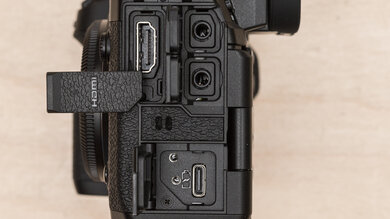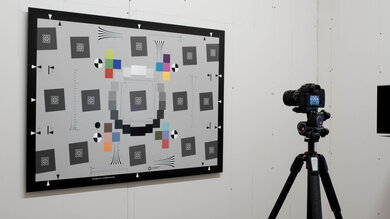
Investing in a mirrorless or DSLR camera is an increasingly viable option for amateur filmmakers who want to produce high-quality videos without spending a fortune on professional video gear. Advanced video features like internal 10-bit color depth and high frame rate options are now featured as a norm on most consumer stills and hybrid cameras—some even support high-quality Apple ProRes codecs and other features previously reserved for dedicated cinema cameras. Generally speaking, when looking for a filmmaking camera, you should consider the camera's video resolution and frame rate options, whether or not you need in-body image stabilization (IBIS), and design features like dual memory card slots and ports to attach peripherals like microphones or external recorders. Of course, budget and ergonomic preferences also play a big role in determining which camera is best for you.
We don't currently test cinema cameras, and because cinema cameras run the gamut from affordable prosumer models to astronomically expensive professional models, this article focuses primarily on consumer stills and hybrid cameras. Note also that your chosen lens will significantly affect your camera's performance, including its stabilization and autofocus performance.
We've bought and tested over 100 cameras in our lab, and below, you'll find our top camera recommendations for aspiring filmmakers and videographers. If you're looking for options that are more tailored to content creators, check out our recommendations for the best cameras for YouTube or the best cameras for vlogging. If you want to record sports videos, you can try the best video cameras for sports, too. Otherwise, check out our best cameras overall.
-
Best Camera For Videography
Studio VideoSensor SizeFull FrameIn-Body Image StabilizationYesMirrorlessYesBody TypeSLR-StyleThe Panasonic LUMIX S5 II is the best camera for videography that we've tested. It's loaded with features that equal and even surpass more expensive options, making it one of the best bang-for-your-buck cameras if you're interested in videography. That includes 6k open gate recording, 4k at 60 fps (albeit with an APS-C crop), and internal 10-bit 4:2:2 capture, with support for a wide range of codecs and recording formats. Video quality from its full-frame sensor is also excellent, and it has one of the best in-body image stabilization (IBIS) systems among full-frame models.
The S5 II is also the first LUMIX camera to feature phase-detection autofocus, giving it significantly improved subject tracking compared to its predecessor, particularly in video mode. It's worth noting that native L-mount lenses can be expensive, although you can get around that by going for third-party options or using a lens-mount adapter. Of course, if you want to save even more money, the original Panasonic LUMIX S5 is a steal, particularly if you buy used and don't need the more advanced autofocus of the S5 II.
-
Best Micro Four Thirds Camera For Videography
Studio VideoSensor Size4/3 (MFT)In-Body Image StabilizationYesMirrorlessYesBody TypeSLR-StyleIf you already have a stable of Micro Four Thirds lenses, the Panasonic LUMIX GH6 is a no-brainer. This is one of the most capable Micro Four Thirds cameras on the market, and its video-centric design makes it one of the best cameras for filmmaking and advanced video work. Unlike the Panasonic LUMIX S5 II above, the GH6 supports features like external RAW video output and internal ProRes codecs out of the box (the S5 II can do those things too, but you need to buy an upgrade key at an additional cost). It also has built-in heat vents to prevent overheating and a unique screen that can both tilt and fully articulate, making it easier to shoot at various angles.
The biggest drawback here is that the GH6 uses Panasonic's older contrast-based autofocus system, which isn't as effective and can create pulsing artifacts in the background of your videos. Ultimately, if you're a solo operator who tends to shoot in less controlled lighting conditions and relies on autofocus, the full-frame S5 II will likely suit you better. On the flip side, if you're a more advanced videographer who needs RAW video output and doesn't mind pulling focus manually, you won't be disappointed by the GH6. With the Panasonic LUMIX GH7 on its way, you'll likely be able to pick up the GH6 for even cheaper soon, too.
-
Best Camera For Action Videography
Studio VideoSensor SizeAPS-CIn-Body Image StabilizationYesMirrorlessYesBody TypeSLR-StyleThe Fujifilm X-H2S is one of the best hybrid cameras in its price range for videographers who need high frame rates and speed. That's because of its 26-megapixel stacked sensor, which keeps rolling shutter to a minimum and makes it a great fit for fast-moving subjects and sweeping action videography. It also supports 6.2k open gate recording, 4k at up to 60 fps without a crop, and a slow-motion recording mode that can capture 4k at up to 120 fps.
Aside from its superb internal recording capabilities, the camera also has all the inputs you'll need for video peripherals, including a full-sized HDMI port, making it easy to connect to an external recorder or display. Like the Panasonic LUMIX GH6, it also supports RAW video output to a compatible external recorder. Even without an external recorder, the camera's internal codec support is fantastic, with Apple ProRes formats to capture higher-quality video with less compression.
-
Best Camera For Low-Light Videography
Studio VideoSensor SizeFull FrameIn-Body Image StabilizationYesMirrorlessYesBody TypeSLR-StyleThe Sony ZV-E1 is one of the best low-light video cameras we've tested. It features a 12 MP full-frame sensor optimized for low-light shooting, with fantastic noise handling and plenty of dynamic range for great results in even the trickiest lighting conditions. It's the same sensor found in the pricier Sony α7S III and Sony FX3—though we haven't tested them, they're known to be some of the best videography cameras in their respective classes. The ZV-E1 is billed as a vlogging camera, so it's more accessible to newcomers and has a more compact body. It also includes Sony's ever-reliable autofocus, IBIS, and 4k recording at up to 60 fps. That said, it can overheat pretty quickly during longer recording sessions.
The Panasonic LUMIX GH5s is another great option for low-light videography that's less likely to overheat. Though it uses a smaller Micro Four Thirds sensor, the sensor's low resolution and dual-native ISO design optimize the camera for low light. The MFT system also features more compact lens options, and the camera has a more effective IBIS system, but its autofocus is much less reliable than the ZV-E1. That may not be a dealbreaker if you prefer to focus manually, so the GH5s is a good choice if you want to save some money.
-
Best Mid-Range Camera For Videography
Studio VideoSensor Size4/3 (MFT)In-Body Image StabilizationYesMirrorlessYesBody TypeSLR-StyleAnother great option for aspiring filmmakers is the Panasonic LUMIX GH5 II. It's the predecessor to the Panasonic LUMIX GH6 above and uses a Micro Four Thirds sensor, albeit with a slightly lower resolution. However, it still delivers excellent overall video quality, and the Four Thirds system has a vast library of lenses to choose from, including plenty of compact and relatively affordable options.
The GH5 II has a wide range of resolution and frame rate options, including anamorphic modes to get a wider, more cinematic aspect ratio and 4k recording at up to 60 fps. You also get Log profiles and 10-bit 4:2:2 4k recording (up to 30 fps) to capture more color information and give you more flexibility in post. Unlike the GH6, however, it lacks a CFexpress card slot, can't shoot in Apple ProRes formats internally, and is a bit more limited in frame rate options. For the price, however, the GH5 II is a fantastic choice.
-
Best Budget Camera For Videography
Studio VideoSensor SizeAPS-CIn-Body Image StabilizationNoMirrorlessYesBody TypeSLR-StyleThe Sony ZV-E10 is the best camera for filmmaking on a tighter budget. While this entry-level APS-C vlogging cam lacks a lot of the more advanced features of our picks above, it's ideal for beginners who are just dipping their toes into videography. Like the higher-end Sony ZV-E1, it lacks a viewfinder, making it less versatile for hybrid shooters, but its fully articulated screen is ideal for video work. The camera is also highly portable for on-the-go shooting, and Sony's E-mount features a wide range of both native and third-party lenses.
Unfortunately, the camera doesn't have in-body stabilization, but you can pair it with optically stabilized lenses to get steadier camera movements. Compared to higher-end options, you'll also miss out on internal 10-bit capture and 4k 60 fps recording. For the price, though, the camera is quite feature-packed, with a fairly wide range of frame rates, including 4k at up to 30 fps and 1080p at up to 120 fps. Overall, it's a great choice for the budget-conscious filmmaker.
Notable Mentions
- Canon EOS R6 Mark II: The Canon EOS R6 Mark II is an excellent full-frame option for filmmakers. It supports internal 10-bit 4:2:2 recording in 4k at up to 60 fps but doesn't offer as many recording formats and codecs as the Fujifilm X-H2S and has worse rolling shutter effect. See our review
- Sony α6700: The Sony α6700 is an excellent mid-range option for hybrid shooters. It can capture 4k video at up to 120 fps, though with a notable crop, and has a reliable autofocus system. However, it's less video-centric than the Panasonic LUMIX GH5 II, with fewer supported recording formats and lacking quality-of-life touches like a full-sized HDMI port. See our review
- Sony α7 IV: The Sony α7 IV is another fantastic hybrid option with advanced video specs. However, it can only record 4k / 60 fps video with a Super35 crop, and unlike the Panasonic LUMIX S5 II, it lacks some video-centric features like vectorscope functionality and RAW video output. See our review
Recent Updates
-
Jul 03, 2024: We added mention of the upcoming Panasonic LUMIX GH7 to provide more context for our recommendation of the Panasonic LUMIX GH6.
-
Jun 03, 2024: We removed the Fujifilm X-T4 from the Notable Mentions because it's discontinued and less relevant for videography in today's market.
-
May 06, 2024: We looked over the picks, including their price and availability, to ensure the article is up to date; the recommended cameras remain the same.
-
Apr 09, 2024: We've updated some of the product photos in the article to be more relevant to videography and filmmaking and checked that the picks were still the best options for users.
-
Mar 14, 2024: We've reviewed the article to ensure the picks and text are still accurate and relevant.
All Reviews
Our recommendations above are what we think are currently the best videography cameras for most people to buy, according to their needs. We factor in the price, feedback from our visitors, and availability (no cameras that are difficult to find or almost out of stock in the U.S.).
If you would like to choose for yourself, here's the list of all our reviews for video-capable cameras. Be careful not to get caught up in the details. There is no single perfect camera. Personal taste, preference, and shooting habits will matter more in your selection.





























